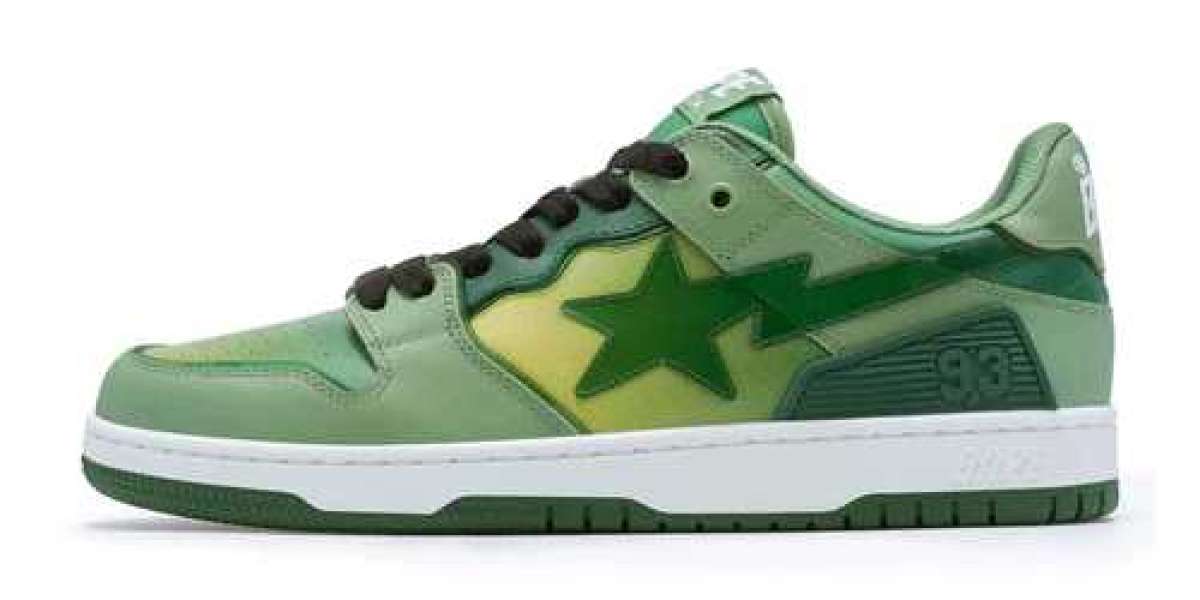In the ever-evolving world of streetwear, certain sneakers transcend trends to become cultural milestones. One such sneaker is the Bapesta, a bold and rebellious silhouette that has left an indelible mark on the fashion landscape. Originating from Japan’s legendary streetwear label A Bathing Ape (BAPE), the Bapesta has carved its own path through music, fashion, and global sneaker communities.
While the world of sneakers has been dominated by giants like Nike, Adidas, and Jordan Brand, the Bapesta emerged as a defiant underdog with undeniable flair. With its unapologetic aesthetic and celebrity endorsements, it evolved from a niche product to a global streetwear statement. Let’s dive into the story behind the Bapesta, why it’s a staple for sneakerheads, and how it continues to inspire today’s fashion culture.
The Origins of Bapesta: Born in Harajuku
The Bapesta was first introduced in the early 2000s by Nigo, the visionary founder of A Bathing Ape. Nigo was already known for blending American pop culture with Japanese craftsmanship, and the Bapesta was no exception. Drawing clear inspiration from the Nike Air Force 1, the Bapesta mirrored the classic basketball silhouette but with a distinctive twist.
Instead of the iconic Swoosh, the Bapesta featured a lightning bolt-shaped “STA” logo, a clever play on branding that instantly set it apart. With patent leather uppers, bold colorways, and glossy finishes, the sneaker screamed individuality in a time when conformity still ruled much of the sneaker market.
The name “Bapesta” itself is a combination of “BAPE” and “STA,” positioning the shoe as BAPE’s signature sneaker line. From the beginning, the Bapesta wasn’t just a sneaker—it was a fashion statement.
Controversy and Copycat Claims: Breaking the Mold
The visual similarity between the Bapesta and the Air Force 1 did not go unnoticed. Critics accused Nigo of creating a knockoff, while others praised his reinterpretation as a work of art. In truth, the Bapesta was more homage than imitation. It embodied the spirit of remixing—an ethos deeply rooted in hip-hop and street culture.
This reinterpretation of an American classic sparked controversy, but it also gained respect among those who saw it as a fearless challenge to the norms of sneaker design. BAPE, already beloved by fashion-forward youth in Japan, suddenly found itself at the heart of a global conversation.
While legal issues were avoided due to slight design differences, the Bapesta served as a bold critique of the gatekeeping present in Western fashion. It dared to remix an icon—and succeeded.
Hip-Hop’s Embrace of the Bapesta
No other cultural movement catapulted the Bapesta into the mainstream quite like hip-hop. In the mid-2000s, the sneaker found its way onto the feet of some of the biggest names in rap. Pharrell Williams, Kanye West, and Lil Wayne were early adopters, often seen rocking exclusive Bapesta colorways and matching BAPE apparel.
This wasn’t accidental. Nigo strategically collaborated with artists who embodied the same spirit of innovation and rebellion. Pharrell, in particular, became closely associated with BAPE and even launched collaborations under his Billionaire Boys Club brand, which Nigo co-founded.
When Kanye West released his own line of Bapesta sneakers—featuring bear graphics reminiscent of his “College Dropout” era—the sneaker was officially cemented as a cultural juggernaut. Suddenly, it wasn’t just a Japanese sneaker. It was a global icon.
Bapesta Collaborations: Art Meets Streetwear
One of the key drivers behind Bapesta’s longevity is its ability to evolve through collaborations. Limited-edition drops with artists, musicians, and brands turned each Bapesta release into a collector’s item.
Over the years, Bapesta has teamed up with:
Marvel Comics for superhero-themed sneakers
SpongeBob SquarePants for quirky pop culture appeal
Undefeated, Stüssy, and Comme des Garçons for high-fashion streetwear mashups
Each collaboration brought new energy and audiences to the Bapesta line, often selling out within hours and later commanding high resale prices. The exclusivity, combined with playful design elements, turned the sneaker into wearable art.
This strategy of constant reinvention has allowed the Bapesta to remain relevant, even as sneaker culture grew more saturated.
The Evolution of Bapesta in the Modern Sneaker Scene
Today’s sneaker market is more crowded than ever. Yet, the Bapesta continues to hold its own. In recent years, A Bathing Ape has re-released classic colorways, refined the silhouette with premium materials, and expanded its presence beyond Asia to flagship stores in New York, Los Angeles, and London.
In contrast to the minimalist trend in modern sneaker design, the Bapesta proudly retains its flashy roots. Glossy finishes, neon colors, and cartoon motifs still dominate the design language, appealing to those who want to stand out rather than blend in.
At the same time, BAPE has introduced more muted and tonal Bapesta editions, catering to the evolving tastes of its loyal fanbase. Whether bold or subtle, each pair continues to represent more than just footwear—it represents a legacy of rebellion and creative expression.
Why Bapesta Still Matters
So why does the Bapesta still matter, two decades after its debut?
First, it represents a moment when streetwear truly went global. The sneaker bridged East and West, blending Tokyo’s avant-garde style with New York’s gritty hip-hop roots. It also helped establish the idea that sneakers could be both fashion and art, deserving of limited releases and museum-level admiration.
Second, the Bapesta challenges conventional ideas of originality and homage. By taking the structure of an American classic and infusing it with Japanese street culture, it sparked debates that still resonate in today’s fashion discourse.
Finally, the Bapesta symbolizes the evolution of streetwear from subculture to mainstream. It’s a relic of the past that still speaks loudly in the present, reminding sneakerheads and fashion lovers alike that the best style often comes from pushing boundaries.
Styling the Bapesta Today
Styling a pair of Bapestas is a fashion statement in itself. Their eye-catching colors and bold lines work best when paired with simple, monochromatic outfits. Think oversized tees, cargo pants, and minimalist outerwear. For those who embrace maximalism, layering BAPE hoodies or camo prints can amplify the streetwear vibe.
Due to their chunky silhouette, Bapestas pair well with both baggy and tapered bottoms. They’re versatile enough to transition from daywear to nightlife, offering a pop of personality wherever you go.
In a world where trends move fast and sneakers come and go, the Bapesta remains a reliable go-to for those who value uniqueness over hype.
The Future of Bapesta: What’s Next?
Looking ahead, the Bapesta shows no signs of slowing down. With Gen Z embracing retro fashion, Y2K nostalgia, and archival streetwear, Bapesta’s return to prominence feels inevitable. Brands are doubling down on storytelling and heritage—and few sneakers have a richer narrative than the Bapesta.
As A Bathing Ape continues to expand its digital and retail footprint, fans can expect new Bapesta drops that fuse technology, sustainability, and timeless design. NFT integration, smart sneaker concepts, and further cross-cultural collaborations may very well be in store.
Conclusion: More Than a Sneaker, It’s a Movement
The Bapesta is more than just a bold sneaker—it’s a symbol of fearless design, cross-cultural innovation, and the enduring power of streetwear. From the streets of Harajuku to the stages of global music icons, it has traveled far and wide, leaving footprints across generations of style lovers.
Whether you’re a seasoned sneakerhead or new to the game, the Bapesta stands as a reminder that fashion is about more than trends—it’s about identity, expression, and daring to be different.








